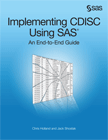Developing a new concept for a book can be daunting, but it can also be very rewarding. Think about The Little SAS Book. I bet Susan Slaughter and Lora Delwiche didn’t know they were stumbling on a huge hit when they created that format.
 I love to see authors create something new. So, when Chris Holland and Jack Shostak submitted a proposal for Implementing CDISC Using SAS: An End-to-End Guide, I was intrigued. When I saw the topic was on CDISC, I was thrilled because we’d never published a book on that topic. So to have a new concept for a new topic, we were really breaking new ground.
I love to see authors create something new. So, when Chris Holland and Jack Shostak submitted a proposal for Implementing CDISC Using SAS: An End-to-End Guide, I was intrigued. When I saw the topic was on CDISC, I was thrilled because we’d never published a book on that topic. So to have a new concept for a new topic, we were really breaking new ground.
I wanted to know what it takes to develop a new concept, so I asked Chris and Jack, “How did you decide on the end-to-end concept? And what made it work for this topic?” Here is their answer, in their own words:
“To be honest, Chris was really the prime mover on this idea. SAS is widely used in the pharmaceutical industry and it is pervasive in the clinical trials data management, analysis, and reporting arena. It has also become prominent in CDISC data model production work. Chris had the idea to do an end-to-end book with regards to CDISC and SAS implementation, and I was honored that he would think of me so I took him up on the idea and opportunity. Two years later, here we are. The book covers an array of SAS offerings from JMP Clinical, to SAS Clinical Data Integration, to the SAS Toolkit, and even our old friend BASE SAS,” said Jack.
And Chris responded, “I guess I've been frustrated at times by the lack of CDISC adoption over the years. You wouldn't know this necessarily from working on CDISC teams because those are, as we statisticians say, biased samples. Having worked at FDA, I was exposed to data from a lot of different submissions - partly from my own projects but mostly from training work I did helping reviewers with their submissions. There was really only a small portion of submissions that had CDISC-compliant data. Though at the same time, I guess I could understand why certain organizations were reluctant to take the CDISC plunge. The standards were, initially, not very stable and there was no real requirement to abide by them.
But then, slowly, the stars came into alignment. The standards stabilized (somewhat), SAS (and JMP) developed CDISC implementation and analysis tools, and my day-job workload lightened a bit. It just seemed like the right time to try to put something out there that would make it harder for organizations to come up with excuses for not adopting to CDISC standards. I thought that by going through the process, showing potential users not only what tools exist but also how to use them, and demonstrating some of the benefits that can be reaped after putting in the time to develop CDISC data, we might have a package of information that SAS users in the pharma industry might find useful.
I could not have done it alone though and Jack was the perfect “partner in crime.” Twenty years ago at my first job out of college Jack was my mentor, a fellow Hokie, and still, to this day, one of the funniest people I've ever had the pleasure to work with. Having been through the book-writing process before (on more than one occasion), being a long-time CDISC implementer, and having experience with some of SAS' CDISC tools made Jack the ideal accomplice.”

1 Comment
No, Lora and I had no idea whether anyone would ever buy our book.
Congratulations to Chris Holland and Jack Shostak on their new book!!